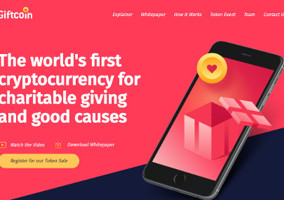A trite way to dismiss someone who seems too gullible is to tell them: “If you believe that then I have a bag of magic beans to sell you.” But in the fairy tale, Jack’s gamble did pay off, even if he did have to outwit a giant.
The same feels true for the emerging world of crypto philanthropy. Like Jack, some people are ending up with golden eggs, but many others come to realise that they have overpaid for a bog standard bag of beans.
On the whole charities, instinctively risk-averse, have steered clear of the cryptocurrency spotlight. But recently one charity became the subplot in a strange tale about a 20-year-old crypto-millionaire, who had turned a small sum into millions by trading cryptocurrencies, and had now pledged to turn his hand to doing good through his own charity token Orfano.
It seemed too good to be true. And it was. The BBC was all set to profile the Orfano’s founder, Hanad Hassan as part of its We Are England series. The episode was promoted across the BBC’s website and radio stations, but the broadcaster was forced to unpublish its news item and drop the documentary from its schedule, when it emerged that the charity token being celebrated had already stopped trading.
Examples such as this might suggest that the industry is still too much like the Wild West for charities to trust anyone’s promise of magic beans, or even just above-average-tasty beans. Is that fair?
What exactly are we talking about?
Digital, or virtual, currencies, such as Bitcoin or Ethereum, known as cryptocurrencies or crypto – are slowly becoming more mainstream. They don’t have any physical representation, but people trade digital tokens or coins in online marketplaces.
Unlike traditional currencies, which are backed by a government or central bank, they exist using a peer-to-peer system. This is one reason they are far more volatile.
These peer-to-peer systems use databases to record all sorts of information such as financial transactions, legal agreements, medical records and more, along with a timestamp.
It is often described as a “distributed ledger system”. Each new block of information is linked to the others using complex computer algorithms, and then stored across a peer-to-peer network, instead of being stored centrally and managed by a single third party.
This makes the network harder to hack than a centralised system, where records are controlled by an intermediary or third party. Records cannot be easily changed after they have been created, without the consent of everyone involved in the blockchain.
Online communities grow around these peer-to-peer networks, and increasingly these communities are looking at what good they can do.
Blockchain’s application goes far beyond currencies. One example with obvious fundraising potential is the growth of non-fungible tokens (NFTs), essentially unique digital artworks, which people collect much in the same way as people would collect football stickers, stamps or physical paintings.
Orfano: Much hype, little impact
So, what happened with Orfano? Was it a scam that used charities to attract investors? Or did the idea just not take off?
It’s hard to tell. Because despite their pledges to be transparent, the founders have pulled up the drawbridge and are not responding to questions.
Orfano marketed itself as a charitable fundraising product, with 3% of each transaction being put into a charity wallet, which the founders would use to donate to charities. Ultimately, the founders planned to set up their own foundation.
“Rather than having a third-party company doing the charity, our community and team volunteers will be out and about doing the hard work and donating to charities and places chosen by the community, this will all be live and on video for the holders to see,” the Orfano website says.
A little bit of investigation suggests that at least some charities did benefit, but not at the scale the platform claimed. But no foundation has been registered with the Charity Commission.
Orfano launched in the spring of last year, and then relaunched in the autumn as OrfanoX before closing abruptly. This left some investors out of pocket and irritated.
On its Twitter profile page, Ofrano claims to have raised £370,000 and distributed £150,000 to good causes. One charity, the Amir Khan Foundation, confirmed that that it had definitely received a £10,000 donation.
Other donations listed on its social media include £7,370 to Save the Children. Confusingly, Orfano tagged the Save the Children’s UK’s press team in its tweets about this donation, but the UK branch of the charity cannot accept cryptocurrencies, although the US branch does have an active cryptocurrency programme, so it seems this is where that donation went.
There is some confusion in unpicking how much money has been raised and donated because in some cases Orfano’s uses sterling and in others it uses US dollars. For simplicity, this piece has converted all figures into sterling.
Orfano’s largest donation was just over £40,000 to Help Yateem, a charity that supports orphans in Africa. As part of this partnership Orfano held a live event on YouTube with representatives from the charity and offered to help the charity develop its crypto giving programme.
Help Yateem has not responded to our requests for confirmation that the charity did receive this donation, and whether it received ongoing support.
In total, the donations that Orfano publicised amount to £63,000, far less than it claimed to have already distributed.
Success stories
Until fairly recently, donations in cryptocurrency were a niche affair. RNLI began accepting Bitcoin donations a few years ago, but raised just a tiny sum of money from the initiative.
But last year, Edinburgh Dog and Cat Home received what it believes is the largest crypto donation in Scottish history, which was enough to cover one of its services for a year.
The Pawthereum community donated 26 Ethereum (approximately £87,000). This will fund the charity’s pet foodbank service, Paws Pantry, for the whole of this year.
Elsewhere, the Giving Block cryptocurrency giving platform said that in 2021 the total donation volume on its platform was $69,644,535, an increase of 1,558% from 2020.
Over 1,000 organisations are now set up to take donations in a variety cryptocurrencies. Although the Giving Block is primarily set-up for an American audience, a handful of UK charities are using the tool.
For example, Children’s Heart Unit Fund has accepted some large donations using the platform, including $100,000 from Moonboys Finance. Just a few months earlier, the charity had celebrated a £38,000 donation in cryptocurrency, which was thought at the time to be the largest cryptocurrency donation to a UK charity.
Advice for charities
So, how should charities weigh up the pros and cons?
Matt Smith, head of development and innovation at THINK Consulting Solutions, says charities should not ignore developments and think of crypto as “the next chapter in money being digitised”.
He adds that it would be a shame if examples such as Orfano discourage charities from exploring the trend.
“It reminds me a lot of the early days of Facebook/Twitter/Insta, when the business cases weren’t particularly obvious. Look at us now!”
Meanwhile, Rhodri Davies, Pears Fellow at the University of Kent’s Centre for Philanthropy, says charities are right to have a “a healthy dose of scepticism” about organisations making big promises, especially about charity-specific coins.
“I used to get approached quite a lot by people who were setting up coins that were going to reinvent the charity sector and their explanations for how they were going to do that were always deeply unconvincing.”
However, he does suggest charities look at where they could engage with existing communities.
“There is a lot of actual money out there that people have made in crypto, and quite a bit of that does seem to be making its way to charities,” he says.
Smith argues that charities shouldn’t be too quick to dismiss potential partners and opportunities.
“By its very nature the crypto space is volatile and totally unlike traditional currencies and markets – that’s the point,” he says. “But the transparency, universality and opportunity are far more exciting that the risks. We also quickly dismiss the same things in traditional finance/currency, for example the 2008 financial crisis didn’t stop any charity working with the banks and investment firms.”
Both Smith and Davies advise charities to do their research and stick to things that have been proven to work.
Davies also advises charities to convert crypto into a traditional currency “as quickly as you can because you're not suffering all the volatility”.
Smith’s advice is to ask potential partners the following: “What’s your track record? What is your roadmap? What contingencies are in place? Who have you worked with in the not-for-profit space already? How can you help us tell your story internally so we can get buy-in?”
At the end of the day, technology is only as ethical as the humans behind it, and as useful as humans have designed it.
Life is not a fairy tale and there are no magic beans. If charities want access to a pool of crypto philanthropists, they will need to do what they have always done: understand the market and position themselves as an ideal partner.
Related articles












